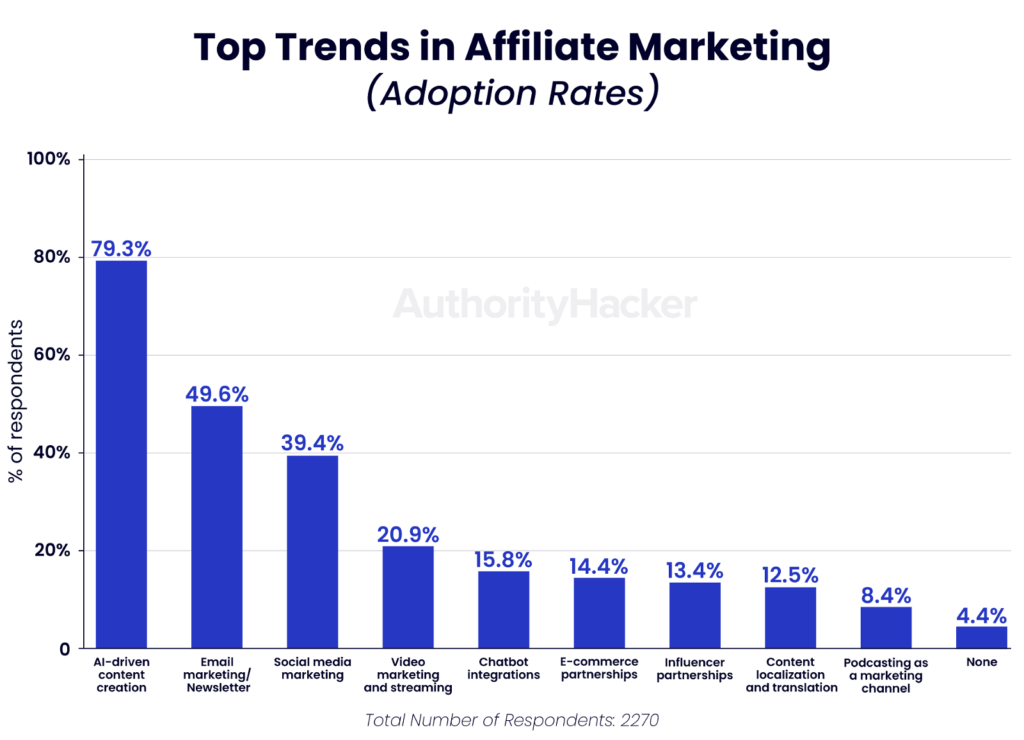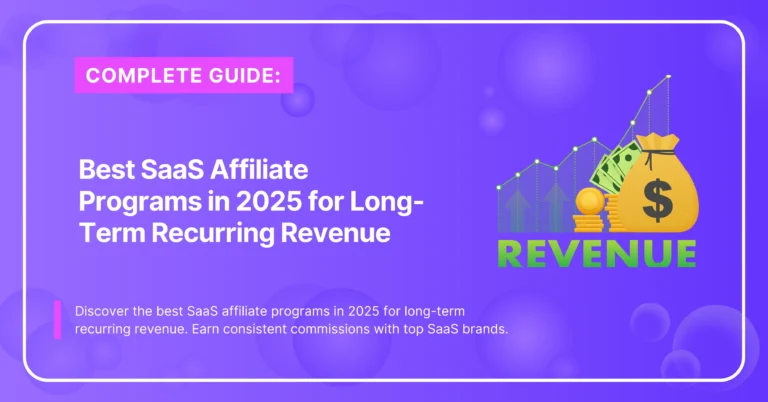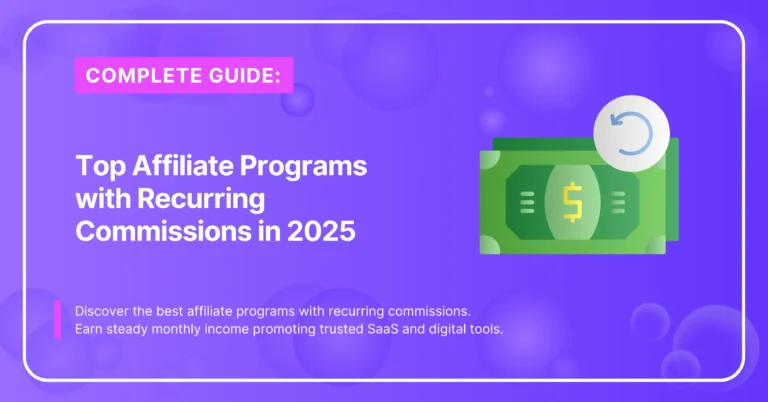Affiliate marketing is one of the most accessible ways to earn online, and you don’t always need a website to get started.
Today, many affiliates successfully promote products directly through platforms like social media, email, and third-party content hubs. This shift reflects how audiences consume content: short, engaging, and direct.

Make Money With AI
Join our Partner Programs!
Boost your reputation, drive revenue and grow your business with CustomGPT.ai.
Instead of building and maintaining a website, affiliates can connect with potential buyers in the spaces they already spend their time — Instagram Stories, TikTok videos, YouTube channels, newsletters, and even communities like Reddit or Quora.
The key to success lies in mastering these alternative platforms, understanding how to share affiliate links effectively, and building trust through transparency.

Basics of Affiliate Marketing
At its core, affiliate marketing works through a special tracking link. When someone clicks your link and makes a purchase (or takes another action, like signing up for a service), you earn a commission.
These links are unique to each affiliate, so the company knows exactly who referred the customer. This makes it simple: your job is to share the link in places where your audience will see it and be encouraged to take action.
Even if you don’t have a website, you can still promote affiliate links through:
- Social media posts (Instagram, TikTok, LinkedIn, etc.)
- Videos (YouTube, Shorts, Reels)
- Emails (newsletters, one-to-one outreach)
- Third-party platforms (Medium, Quora, Reddit)
What matters most is choosing the right platform for your audience and making sure your promotions feel natural, helpful, and trustworthy.
Why a Website Isn’t Necessary
A common misconception is that you need a website to start affiliate marketing. In reality, many successful affiliates build their income entirely on social media, email, and community-driven platforms.
The big advantage of this approach is speed and accessibility. Instead of setting up and maintaining a website, you can share affiliate links directly in places where your audience already spends their time.
Social platforms like Instagram, TikTok, and YouTube offer built-in tools—stories, reels, or video descriptions—that make it easy to promote products in a way that feels authentic.
This also allows affiliates to adapt quickly. Content can be updated or adjusted instantly based on what resonates with the audience, without the technical work of editing a website.
Of course, this method requires understanding each platform’s rules, algorithms, and audience preferences. But for those who want to get started without the barriers of building a site, it’s an effective, fast-moving way to generate results.

Image source: authorityhacker.com
Leveraging Social Media for Affiliate Promotion
Social media is one of the most powerful ways to promote affiliate links without the need for a traditional website. These platforms already have massive, highly engaged audiences, and their features are designed to make sharing and interaction seamless.
One more powerful approach is using AI-powered social media analysis to track engagement, understand audience behavior, and refine affiliate campaigns for better results.
Each platform has its own strengths, audience behaviors, and promotional styles, so affiliates must adapt their strategies accordingly.
Different platforms work in different ways:
Instagram’s strength lies in visual storytelling. Instagram is perfect for products that shine visually, from lifestyle to tech gadgets. Instead of relying on static posts alone, affiliates can:
- Use Stories with link stickers to drive quick clicks.
- Create Reels that show a product in action within 15–30 seconds.
- Add a link hub (Linktree, Beacons) in bio so followers can easily access multiple offers.
Pro tip: Keep promotions conversational—followers trust genuine recommendations over polished ads.
TikTok
TikTok thrives on short, authentic, and engaging content. Quick product demos, “how-to” clips, and trend-based videos can attract massive reach thanks to TikTok’s algorithm.
Affiliates succeed here by:
- Posting short demos or tutorials using trending sounds.
- Joining hashtag challenges to increase reach organically.
- Leveraging storytelling to show “before and after” results or real use cases.
Pro tip: Post frequently—consistency is crucial to stay in the algorithm’s favor. Since attention spans are short, grabbing attention in the first few seconds is critical. Hashtag challenges and collaborations with micro-influencers can also extend your reach.
For links, many affiliates guide users to their TikTok bio where a single hub page (like Linktree) houses multiple offers.
YouTube
YouTube is one of the best platforms for affiliates who want to build credibility and give their audience deeper insights into products.
Unlike Instagram or TikTok, YouTube’s long-form content makes it possible to showcase detailed product reviews, tutorials, and comparisons that help viewers make informed buying decisions.
Key strategies for YouTube affiliate marketing:
- In-depth product reviews: Explaining features, pros, cons, and use cases builds trust with your audience.
- Tutorials and how-to content: Showing how a product solves a real problem encourages natural link clicks.
- Strategic link placement: Place affiliate links in video descriptions, pinned comments, or even as on-screen mentions, but avoid overwhelming viewers with too many links.
- Timestamps for relevance: Guide viewers to specific moments in your video and match them with affiliate links for a smoother experience.
- Call-to-actions: Encourage viewers to “check the link in the description” naturally within your video.
YouTube works best for affiliates who want to create evergreen content—videos that continue driving clicks and conversions long after they’re published.
LinkedIn is ideal for affiliates in B2B niches or promoting professional services and software tools. Strategies include:
- Write thought-leadership posts or articles where affiliate links fit naturally.
- Share case studies, product breakdowns, or tool comparisons relevant to professionals.
- Participate in LinkedIn groups to recommend solutions organically.
Pro tip: On LinkedIn, credibility is everything. Because LinkedIn emphasizes authority and expertise, affiliates should prioritize educational and insight-driven content rather than overt promotions. Frame links as professional resources, not sales pitches.
Email Marketing Strategies for Affiliate Links
Email marketing remains one of the most reliable ways to promote affiliate links—especially for those without a website.
With email, affiliates control the audience, the message, and the timing, unlike social media platforms where algorithms dictate reach.
Building an Email List Without a Website
Not having a website doesn’t mean you can’t build an email list. Today, many tools and platforms allow affiliates to capture leads directly and start nurturing them through email campaigns.
Ways to build an email list without a website
- Social media profiles: Use platforms like Instagram, TikTok, or LinkedIn to direct followers to a sign-up form hosted by tools such as Mailchimp or ConvertKit.
- Standalone landing pages: Email marketing tools provide hosted landing pages you can share in bios or posts, no website needed.
- Lead magnets: Offer something of value (a free guide, checklist, or mini-course) in exchange for an email sign-up.
- Communities and groups: Participate in forums, Reddit communities, or Facebook Groups and share opt-in links with members interested in your niche.
- Collaborations: Partner with influencers or creators in your niche to promote your email sign-up form to their audience.
Why it works
This method allows affiliates to own their audience without relying on a website. Social platforms or third-party communities may change algorithms or policies, but your email list is an asset you control and can use long-term for affiliate promotions.
Crafting Compelling Newsletters
Once you’ve built an email list, the next step is keeping subscribers engaged with valuable content. A newsletter isn’t just about pushing links—it’s about building trust and providing consistent value.
Best practices for affiliate newsletters:
- Lead with value: Share tips, insights, or resources your audience cares about. For example, if you promote fitness products, include short workout routines or nutrition advice.
- Use problem–solution storytelling: Frame a common challenge, then introduce an affiliate product as part of the solution. This feels natural and helps readers see the product’s relevance.
- Keep it personal and relatable: Write as if speaking directly to one person, not a list. Authenticity encourages loyalty.
- Balance content and promotion: Avoid stuffing newsletters with too many links. A good ratio is 80% useful content, 20% promotion.
- Experiment with formats: Try curated roundups, Q&A sections, or short tutorials to keep readers engaged.
Why it works
A compelling newsletter turns your subscribers into a loyal audience that trusts your recommendations.
By consistently providing value, your affiliate links feel like helpful suggestions rather than sales pitches, leading to better click-through and conversion rates.
Best Practices for Email Affiliate Marketing
- Build an engaged list: Focus on growing a list of people genuinely interested in your niche. Quality is more important than quantity.
- Segment your audience: Group subscribers based on interests or behaviors to send more targeted affiliate offers.
- Provide value first: Don’t just send product links. Share tips, tutorials, or insights and weave affiliate products naturally into the content.
- Use newsletters: Regular updates with helpful content (e.g., “weekly tools roundup” or “fitness hacks of the week”) keep readers engaged and make affiliate links feel more natural.
- Clear calls-to-action: Make it simple for readers to click through by using strong CTAs like “See today’s recommended tool.”
The key is to build trust and consistency. If subscribers know your emails always provide useful content, they’ll be more likely to click your affiliate links when you recommend products.
Utilizing Third-Party Content Platforms
You don’t always need your own website to create valuable content. Platforms like Medium, Quora, and Reddit already have established audiences and built-in trust.
By contributing meaningfully, you can share affiliate links in ways that feel natural and helpful.
Medium
Medium is ideal for long-form storytelling and educational content. Affiliates can write tutorials, guides, or case studies that integrate links into problem-solving narratives.
- Publish actionable how-to articles that address real audience pain points.
- Position affiliate links as part of the solution, not the focus.
- Use engaging titles and SEO-friendly formatting to improve visibility.
Quora
Quora rewards clarity and precision. Users search for answers to specific questions, and well-written responses can gain long-term visibility.
- Focus on providing detailed, helpful answers that build credibility.
- Add affiliate links only when they directly enhance the solution.
- Keep transparency by clarifying the purpose of the link to build trust.
Reddit thrives on authenticity and community-driven conversations. Unlike other platforms, Reddit users dislike overt promotions, so subtlety is essential.
- Contribute value-first posts in niche subreddits aligned with your offer.
- Use a “comment-first” approach: help others, then share links where relevant.
- Always disclose affiliate relationships to maintain compliance and trust.
Paid Advertising Techniques for Direct Linking
Paid ads can be a powerful way to promote affiliate links. Instead of sending traffic to a landing page, direct linking sends users straight to the affiliate offer.
Done right, it saves time and can scale fast—though it requires precision and compliance with platform rules.
Understanding PPC and Media Buying
Pay-per-click (PPC) platforms like Google Ads, Facebook Ads, and TikTok Ads allow affiliates to reach highly targeted audiences. Success depends on:
- Keyword targeting: focusing on buyer-intent searches such as “best email marketing software” instead of broad terms like “email.”
- Ad relevance: aligning ad copy with user intent ensures higher quality scores and lower costs.
- Creative testing: running multiple versions of headlines, images, and videos to find top performers.
Media buying on native ad networks (Taboola, Outbrain) or display ads can also work for niches like finance, SaaS, and e-commerce.
Pre-Sell Ads for Better Conversions
Direct linking often skips context, which can lower trust. Pre-sell ads solve this by warming up the audience before sending them to the affiliate link.
Examples include:
- A short article-style ad that highlights a problem and solution.
- A quick video ad with a personal story or demo.
- A simple landing page that provides helpful info before the affiliate offer.
These approaches prime users, increasing click-through rates and conversions.
Tracking and Analytics for Paid Campaigns
Direct linking leaves little room for error—you need accurate tracking to understand which ads generate sales. Affiliates can use:
- Affiliate network dashboards (ClickBank, CJ, Impact) to monitor clicks and conversions.
- Server-to-server tracking for more accurate attribution, especially with stricter privacy rules.
- UTM parameters in ad URLs to analyze ad performance in Google Analytics.
- A/B testing to compare different targeting, creatives, or placements.
Pro tip: Start with a small budget to validate campaigns before scaling.
Best Practices and Compliance
Promoting affiliate links without a website requires more than strategy—it requires trust and compliance. Transparency and ethical marketing ensure long-term success.
- Disclose affiliate relationships: Always include a clear statement such as “This post contains affiliate links, and I may earn a commission at no extra cost to you.”
- Follow platform rules: Each platform (Instagram, TikTok, YouTube, etc.) has guidelines on promotions. Violating them can get accounts flagged or banned.
- Prioritize value over sales: Build content that helps or educates your audience. The affiliate link should feel like a natural recommendation.
- Don’t overuse links: Too many links look spammy and reduce trust. Use link hubs (e.g., Linktree) for better organization.
- Stay up to date with policies: Ad and social media policies evolve quickly—regularly review changes to avoid compliance issues.
“Ethical marketing practices are not just legal obligations; they are trust-building tools,”
— Dr. Sarah Lin, Digital Marketing Strategist
By integrating these practices, affiliates can safeguard their reputation while optimizing long-term performance. For businesses needing a centralized AI platform to streamline compliance and content management, our solution offers unparalleled support.
FAQ
What are the best platforms for promoting affiliate links without a website?
The most effective platforms include Instagram, TikTok, YouTube, and LinkedIn for social engagement, as well as email marketing tools like Mailchimp or ConvertKit for direct communication.
Community-based platforms such as Reddit and Quora also allow affiliates to share insights and embed links contextually. The right platform depends on your niche and where your audience spends time.
How can social media algorithms affect affiliate marketing?
Social media algorithms prioritize content based on engagement—likes, comments, shares, and watch time. Overly promotional posts often perform poorly, while educational, entertaining, or authentic content gets boosted.
To maximize reach, affiliates should create content that sparks interaction while subtly integrating affiliate links.
What tools can help affiliates manage campaigns without a website?
Link hubs (Linktree, Beacons) to organize multiple links in one place.
AI writing assistants (CustomGPT.ai Researcher, Jasper) to create platform-specific content.
Analytics tools (Google Analytics, Tapfiliate) to track clicks and conversions.
Scheduling tools (Buffer, Later) to optimize posting times.
These tools streamline workflows and help affiliates stay consistent across platforms.
Do I need to disclose affiliate links on social platforms?
Yes. Disclosure is both a legal requirement (FTC guidelines) and a trust-building practice. Use simple, clear phrases like “This post contains affiliate links” or “I may earn a commission if you purchase through this link.” Place disclosures where they’re visible—at the start of posts, in video captions, or within spoken content for videos.
Can I run paid ads directly to affiliate links?
Yes, but it depends on the rules of the affiliate program and the ad platform. Some networks allow direct linking, while others require a pre-sell page.
Platforms like Google and Facebook may restrict certain niches (e.g., health or finance). Always check policies first and use pre-sell ads when direct linking isn’t allowed.
Conclusion
Promoting affiliate links without a website is not just possible — it’s a growing strategy that gives marketers flexibility and reach.
Whether you’re on Instagram, YouTube, Reddit, or email, success depends on three things: authenticity, consistency, and trust. With the right mix of platforms and tools, you can generate steady affiliate income without needing a traditional website.
Call to Action
Ready to put these strategies into action? Join the CustomGPT.ai Affiliate Program today and start earning by promoting cutting-edge AI solutions. As an affiliate, you’ll get access to marketing resources, support, and generous commissions — no website required.






